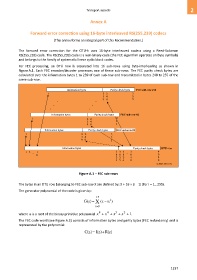Page 1247 - 5G Basics - Core Network Aspects
P. 1247
Transport aspects 2
Annex A
Forward error correction using 16-byte interleaved RS(255,239) codecs
(This annex forms an integral part of this Recommendation.)
The forward error correction for the OTU-k uses 16-byte interleaved codecs using a Reed-Solomon
RS(255,239) code. The RS(255,239) code is a non-binary code (the FEC algorithm operates on byte symbols)
and belongs to the family of systematic linear cyclic block codes.
For FEC processing, an OTU row is separated into 16 sub-rows using byte-interleaving as shown in
Figure A.1. Each FEC encoder/decoder processes one of these sub-rows. The FEC parity check bytes are
calculated over the information bytes 1 to 239 of each sub-row and transmitted in bytes 240 to 255 of the
same sub-row.
Information bytes Parity check bytes FEC sub-row #16
1 2 2 2
3 4 5
9 0 5
Information bytes Parity check bytes FEC sub-row #2
1 2 2 2
3 4 5
9 0 5
Information bytes Parity check bytes FEC sub-row #1
1 2 2 2
3 4 5
9 0 5
Information bytes Parity check bytes OTU row
1 2 ... 1 3 3 3 ... 3 4
6 8 8 8 8 0
2 2 2 4 8
4 5 6 0 0
G.709/Y.1331_FA.1
Figure A.1 FEC sub-rows
The bytes in an OTU row belonging to FEC sub-row X are defined by: X + 16 × (i 1) (for i = 1...255).
The generator polynomial of the code is given by:
15
G(z) z ( i )
i 0
where is a root of the binary primitive polynomial x 8 x 4 x 3 x 2 . 1
The FEC code word (see Figure A.2) consists of information bytes and parity bytes (FEC redundancy) and is
represented by the polynomial:
C(z) I(z) R(z)
1237

